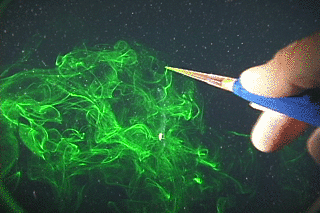The Ed's Up #99
The $1 Pocket Microscope
"It took about six months for the jungle to kill Aaron Pomerantz’s microscope. Thanks to the sweltering humidity, water started condensing on all the microscope’s glass components. Soon, it was caked in fungus. An entomologist without a microscope is like an astronomer without a telescope, so Pomerantz needed a replacement. Ideally, he wanted something portable enough to carry while hiking, robust enough to withstand the Amazon, and cheap enough to avoid breaking his budget. After a quick search, he learned that 5,000 miles away, a Stanford University engineer named Manu Prakash had been building exactly what he wanted." (Image: Aaron Pomerantz)
Is That a Colony of Conjoined Twins or a Single Sea Creature?
The creature is Nanomia bijuga. It’s a translucent, gelatinous blob with no brain and very simple muscles. And yet, it is clearly an excellent swimmer. In the GIF, above, a scientist injects fluorescent dye in front of it to highlight its movements. Look at its twists, its turns, its sudden changes in direction. “They are amazingly maneuverable,” says Jack Costello from the Marine Biology Laboratory in Woods Hole, Massachusetts. “They can go sideways. They can do loop the loops. They can back up.” The secret of Nanomia’s surprising agility is teamwork. It may look like a single animal, but it’s not.The Phantom Road
In the autumns of 2012 and 2013, any hikers walking along a particular ridge in Idaho’s Lucky Peak would have become very confused. One minute they’d be enjoying the tranquil chirps and rustles of a temperate woodland. The next, they’d be immersed in the unnervingly realistic sounds of a roadway: metal rushing past at speed, tires rolling over asphalt, honking horns. These noises were coming from 15 pairs of large bullhorn speakers that had been lashed to the trees. The hikers were walking along a phantom road. This half-mile corridor of disembodied sound, this road in noise only, was built to answer a simple question: How does the bustle of traffic affect the presence and health of birds? (Image: Callie Gesmundo)
Bug Stops Food Halfway Down Its Gut to Make Room for Microbes
Your gut is a long continuous tube. Food goes in one end, gets digested and stripped of nutrients, and is shunted out the other end. That’s the case in ants and elephants, lions and sea lions, hawks and hawk moths. But not in stinkbugs. In the guts of these sap-sucking, shield-shaped insects, food goes in one end, gets digested and stripped of nutrients… and then stops. It never flows into the back half of the gut. That end of the organ has been transformed from a site of digestion, into an apartment complex for microbes. (Image: Gilles San Martin)
More good reads
- An incredible year-long investigation from Bryan Christy shows how ivory poaching funds terrorism.
- Brooke Borel on the hidden challenge faced by marijuana growers: a regulatory tangle that deprives them of good pesticides
- "The world's longest yard sale runs for nearly 700 miles along a vertical line connecting Alabama & Michigan". By Helen Rosner.
- RIP Oliver Sacks. Here’s Robert Krulwich's moving tribute
- Their village is going to be swept away, but the people of Newtok, Alaska have nowhere to go. By Alana Semuels
- The Summer That Never Was - not a whine about the weather, but a rather beautiful lament about hope and expectations
- A vaccinated man has been shedding virulent polio for 28 years. What does this mean for eradication? By Maryn McKenna
- Why are there fish 8,370 metres below the ocean surface but none at 8,400 metres? By Rebecca Helm
- "It’s just this kind of situation that prompted Scotland Yard to form a team of super-recognizers." By Erika Engelhaupt.
- What To Do When Someone Gives You A Giant Squid: Call in a bunch of favours and buy loads of rubber gloves, basically. By Hayley Campbell
More good links will be released in tomorrow's linkfest on Not Exactly Rocket Science.
You can also follow me on Twitter, find regular writing on my blog. If someone has forwarded this email to you, you can sign up yourself.
And that's it! Thanks for reading.
-Ed



